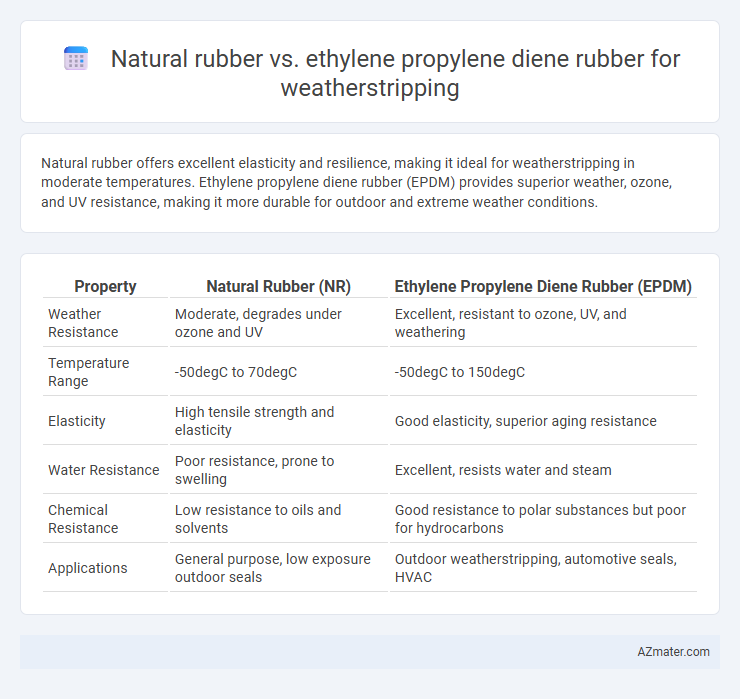Natural rubber offers excellent elasticity and resilience, making it ideal for weatherstripping in moderate temperatures. Ethylene propylene diene rubber (EPDM) provides superior weather, ozone, and UV resistance, making it more durable for outdoor and extreme weather conditions.
Table of Comparison
| Property | Natural Rubber (NR) | Ethylene Propylene Diene Rubber (EPDM) |
|---|---|---|
| Weather Resistance | Moderate, degrades under ozone and UV | Excellent, resistant to ozone, UV, and weathering |
| Temperature Range | -50degC to 70degC | -50degC to 150degC |
| Elasticity | High tensile strength and elasticity | Good elasticity, superior aging resistance |
| Water Resistance | Poor resistance, prone to swelling | Excellent, resists water and steam |
| Chemical Resistance | Low resistance to oils and solvents | Good resistance to polar substances but poor for hydrocarbons |
| Applications | General purpose, low exposure outdoor seals | Outdoor weatherstripping, automotive seals, HVAC |
Introduction to Weatherstripping Materials
Natural rubber offers excellent elasticity and resilience, making it ideal for weatherstripping applications that require tight seals and flexibility under varying temperatures. Ethylene propylene diene rubber (EPDM) excels in weather resistance, UV stability, and ozone resistance, ensuring long-lasting performance in outdoor and harsh environmental conditions. Choosing between natural rubber and EPDM depends on factors such as exposure to sunlight, temperature extremes, and chemical resistance requirements for specific weatherstripping uses.
Overview of Natural Rubber
Natural rubber, derived from latex sap of the Hevea brasiliensis tree, offers excellent elasticity, resilience, and tensile strength, making it ideal for weatherstripping applications requiring flexibility and durability. Its superior resistance to abrasion and good sealing properties provide effective protection against moisture, dust, and air infiltration in varying environmental conditions. However, natural rubber's susceptibility to ozone, UV degradation, and chemical exposure limits its use in harsh outdoor environments compared to synthetic alternatives like ethylene propylene diene monomer (EPDM).
Overview of Ethylene Propylene Diene Rubber (EPDM)
Ethylene Propylene Diene Rubber (EPDM) is a synthetic elastomer known for its exceptional resistance to weathering, ozone, UV rays, and temperature extremes, making it highly suitable for weatherstripping applications. Compared to natural rubber, EPDM offers superior durability and longevity in outdoor environments, maintaining flexibility and sealing performance under harsh atmospheric conditions. Its chemical stability and resistance to water, steam, and polar substances further enhance its reliability in sealing and insulation tasks.
Weather Resistance Comparison
Ethylene propylene diene rubber (EPDM) exhibits superior weather resistance compared to natural rubber, maintaining flexibility and structural integrity under prolonged exposure to UV rays, ozone, and extreme temperatures. Natural rubber tends to degrade faster with cracking and hardening when exposed to sunlight and oxidative elements, reducing its effectiveness in weatherstripping applications. EPDM's enhanced resistance to environmental factors makes it the preferred choice for durable and long-lasting weatherstripping seals.
Durability and Longevity
Natural rubber exhibits excellent elasticity and tensile strength but degrades rapidly under UV exposure, ozone, and extreme weather conditions, limiting its durability for weatherstripping applications. Ethylene propylene diene monomer (EPDM) rubber offers superior resistance to weathering, ozone, and thermal aging, resulting in significantly longer service life and enhanced longevity in outdoor environments. EPDM's robust chemical stability and aging characteristics make it the preferred choice for weatherstripping requiring extended durability and reliable performance.
Flexibility and Performance in Extreme Temperatures
Natural rubber offers superior flexibility and excellent resilience at low temperatures, making it ideal for weatherstripping applications requiring tight seals and frequent movement. Ethylene propylene diene rubber (EPDM) excels in performance under extreme temperature ranges from -50degC to 150degC, providing outstanding resistance to UV, ozone, and weather aging. While natural rubber softens in heat and hardens in cold, EPDM maintains consistent elasticity and durability, ensuring long-lasting weatherproofing in harsh environments.
Cost Analysis: Natural Rubber vs EPDM
Natural rubber offers a lower initial cost compared to ethylene propylene diene monomer (EPDM), making it a budget-friendly option for weatherstripping applications. However, EPDM's superior durability and resistance to UV rays, ozone, and extreme temperatures reduce long-term replacement and maintenance expenses. When analyzing total lifecycle costs, EPDM often proves more cost-effective despite its higher upfront price due to enhanced weather resistance and extended service life.
Environmental Impact and Sustainability
Natural rubber, derived from the latex of rubber trees, offers superior biodegradability and a lower carbon footprint compared to Ethylene Propylene Diene Monomer (EPDM) rubber, which is synthetic and petroleum-based. EPDM's production involves non-renewable resources and generates more greenhouse gases, whereas natural rubber sourcing supports renewable cultivation and carbon sequestration. Despite EPDM's longer durability in harsh weather conditions, natural rubber remains a more environmentally sustainable option for weatherstripping applications.
Common Applications in Weatherstripping
Natural rubber is widely used in weatherstripping for automotive door seals, window gaskets, and HVAC systems due to its excellent elasticity and strong resistance to tearing. Ethylene propylene diene rubber (EPDM) is preferred for exterior weatherstripping applications such as roofing seals, outdoor window seals, and marine weatherproofing because of its superior resistance to UV rays, ozone, and extreme weather conditions. Both materials contribute to airtight and watertight sealing, but EPDM is favored for long-term durability in harsh environments while natural rubber excels in flexible, indoor applications.
Choosing the Right Rubber for Your Needs
Natural rubber offers excellent elasticity and resilience, making it ideal for weatherstripping applications requiring superior flexibility and strong sealing against moisture and wind. Ethylene propylene diene monomer (EPDM) rubber excels in resistance to ozone, UV rays, and extreme temperatures, providing long-lasting durability in outdoor and automotive weatherstripping. Choosing the right rubber depends on evaluating environmental exposure, temperature range, and required durability to ensure effective sealing performance.

Infographic: Natural rubber vs Ethylene propylene diene rubber for Weatherstripping
 azmater.com
azmater.com